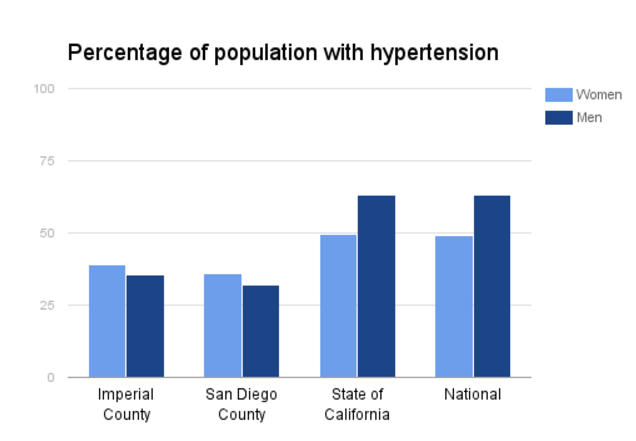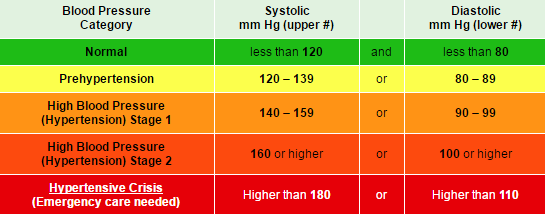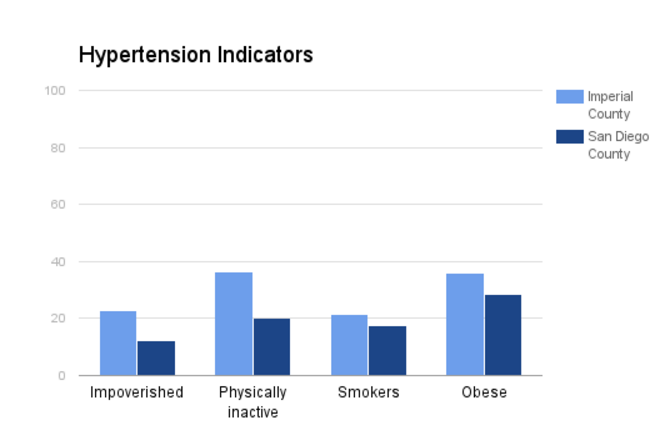May 27, 2016
Do you know your blood pressure?
The month of May brought our first taste of summer—as well as an important reminder about our health. Officially coined “National High Blood Pressure Education Month,” May serves to raise awareness about one of the leading causes of death worldwide, giving us the opportunity to explore how we can take preventative measures in our own communities to improve our blood pressure stats.
For underserved populations in both San Diego and Imperial counties, high blood pressure—called “hypertension”—is an especially critical issue that needs to be addressed. Similar to other populations, diet and exercise are significant contributors to high blood pressure in underserved communities. Yet as we might expect, they also face unique challenges that not only make high blood pressure a more prevalent issue, but a more difficult one to remedy. Lack of education about blood pressure health, lack of medical care, and food insecurity are just a few examples of these challenges. As we address our own health concerns, we also look to our community resources to consider how we can help improve these numbers across the board—especially of the underserved.
Hypertension in San Diego and Imperial Counties: How do we compare?
High blood pressure is a nationwide (and in truth, worldwide) issue, though we’re happy to report that by comparison to national and even state averages, both San Diego and Imperial Counties rank fairly well. Interestingly, women in both counties more commonly experience high blood pressure than men, while the reverse is true on the national and state level. Imperial County shows a slightly higher average for hypertension as compared to San Diego, though not substantially different.
Hypertension in both counties has shown a decrease in recent years, likely due to increasing awareness and education about the disease and how to prevent it.
Among the populations we serve, women in Imperial County break the record at a 39.2% rate of hypertension, well over the national average. This indicates that hypertension, especially in women, is a distinct and prevalent issue in Imperial County.
You can find more data on this U.S. health map.
What is high blood pressure? Why is it so dangerous?
Blood pressure refers to the force with which blood pushes against arterial walls each time the heart beats. Blood pressure is comprised of two data pieces: systolic and diastolic pressure.
- Systolic Pressure: blood pressure when the heart beats while pumping blood
- Diastolic Pressure: pressure when the heart is at rest
High blood pressure results when one or both of these numbers increases above healthy standards.
Rated by the World Health Organization (WHO) as one of the leading causes of premature death worldwide, high blood pressure is a silent killer in that it leads to coronary heart failure as well as a variety of secondary disease.
What is considered a healthy blood pressure?
While healthy blood pressure varies from person to person, 120/80 and below is generally considered healthy, while 140/90 is considered “prehypertension.”
What are the symptoms of high blood pressure?
There are often no symptoms of high blood pressure, even when it has already reached dangerously high levels. In some cases, individuals report headaches, shortness of breath and nosebleeds. Be sure to consult your physician with questions related to your blood pressure and general health.
Top contributors to high blood pressure:
The top three behaviors that contribute to high blood pressure are poor diet, physical inactivity, and tobacco use. As you can see in the chart below, Imperial County has significantly higher instances of all hypertension indicators, which likely originates from poverty levels, high unemployment rates, and other complicating factors like food insecurity.
How can I address high blood pressure?
The first step is simply to get tested. Kiosks are available at many pharmacies, including CVS and Walgreens. You can also choose to purchase a home blood pressure kit or to learn your blood pressure during a regular visit to your physician.
Managing high blood pressure—and preventing pre-hypertension from advancing—can largely be done through lifestyle management. Regulating and reducing stress, eating a healthy diet and maintaining a healthy body weight, getting enough physical activity, not smoking, and limiting alcohol use are all excellent measures to take. In some cases, medication is also needed to maintain a healthy level blood pressure. Be sure to consult your physician to determine the best course of action for you.
How AHF is making a difference locally
Underserved populations such as the homeless or impoverished are more likely to have cardiovascular disease. Alliance Healthcare Foundation works with grantees like the UCSD Student-Run Free Clinic and Health Care Partners, formerly called Council of Community Clinics in San Diego County and has worked with Clinicas de Salud del Pueblo in Imperial County to help remedy this issue. These organizations are doing their part to reduce cardiovascular disease among lower income and homeless populations in San Diego and Imperial Counties through education and awareness as well as through daily services.
What other questions do you have about high blood pressure? Do you have a success story you can share? We’d love to hear about your experiences and what you’ve done to improve your health!
– Nancy Sasaki, Executive Director
Alliance Healthcare Foundation
NSasaki@AllianceHF.org
About Alliance Healthcare Foundation
Alliance Healthcare Foundation is a San Diego-based nonprofit which works with nonprofit, government and community agencies to advance health and wellness throughout the San Diego and Imperial Counties. AHF works to serve the most vulnerable – the poor, working poor, children and homeless by providing grants, advocacy and education to support its region.
To learn more about AHF, visit: AHF on Facebook, AHF on LinkedIn, AHF on Google+, AHF on YouTube, AHF on Twitter
To learn more about our grantees, visit our Grantee Page.
Related News
Jul 29, 2016
One More Step: Our Critical Role in Medi-Cal Coverage for All Children
In May of 2016, California bill SB 75 officially extended health coverage for low-income undocumented immigrant children 18 years old and younger under what is known as Medi-Cal For All Children. While this change represents another critical step towards coverage for all, we must now play an increasingly important role in informing and assisting local families to complete the enrollment process, as required, so that their children will receive all of the care now available.
Jun 23, 2016
Men’s Health Month
Men’s Health Month—Up Your Game. Improve Your Heart Health. As [...]
May 11, 2016
Imperial County | Food Insecurity & Childhood Asthma
Food Insecurity & Childhood Asthma Alliance Healthcare Foundation (AHF) works [...]





